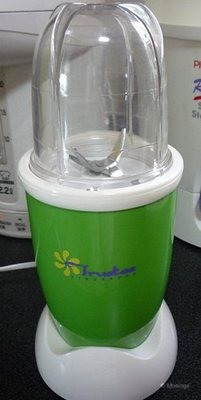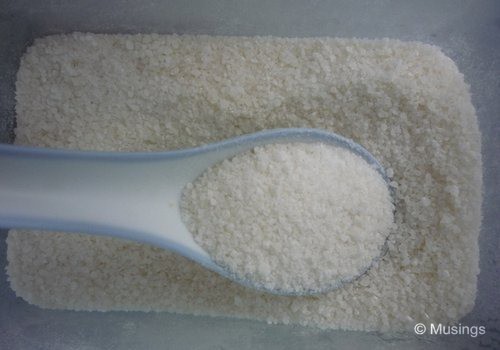 Grinding rice grains helps to cut down time required to cook them into soft porridge. It takes a bit of trouble to get it done but the convenience that comes later is worth it. So here’s what I did after reading up on the how-to from other mommies on the Internet. (This is especially useful if cooking is done over the stove. Cooking porridge over stove fire requires constant stirring to prevent rice grains from sticking to the base of pot and getting burnt. Using ground rice grains would therefore reduces the amount of time spent on stirring! If the slow cooker is used instead, this process is unnecessary because no stirring is required.)
Grinding rice grains helps to cut down time required to cook them into soft porridge. It takes a bit of trouble to get it done but the convenience that comes later is worth it. So here’s what I did after reading up on the how-to from other mommies on the Internet. (This is especially useful if cooking is done over the stove. Cooking porridge over stove fire requires constant stirring to prevent rice grains from sticking to the base of pot and getting burnt. Using ground rice grains would therefore reduces the amount of time spent on stirring! If the slow cooker is used instead, this process is unnecessary because no stirring is required.)
Procedure
1) Wash the rice grains and drain well.
2) On a metal tray that is wrapped in an aluminum foil, spread out the rice grains evenly.
3) Set the temperature of the oven to about 50 degree celsius and dry the rice grains for about 30 minutes or so.
4) Check the rice grains for dampness by running a spoon or your clean fingers through them. If they move freely / feel dry, set them aside to cool down.
5) Grind the grains using an electric grinder until you get your desired consistency. (My grinder is ‘Trustee’. I understand that it is called ‘U-like’ now.)
6) Transfer the ground rice grains into an air-tight container. I used ‘lock & lock’ and ‘biokips’ to store both my ground brown and white rice grains.
7) Store the containers in the refrigerator. Try to use up the ground rice grains within a month. (This should enable you to estimate the amount to grind.)

wa, like neslac… i love neslac =D
Oh no!! I didn’t wash the grains before grinding them! Does it matter??
Hi Lisa,
Aiyah, need to wash. Just like we normally rinse the rice grains once or twice b4 cooking. Since you have already ground them, just rinse the portion you take out to cook each time. Having said that, some nutrients will be washed away in the rinsing.
BTW, are you using slow cooker to cook porridge? If that’s the case, no need to grind the rice grains (save yourself the trouble). Just cook the porridge for one hour, give it a good stir at the end, the porridge would be soft and just as good. :)
O dear… I’m not sure if my mom or my helper has been washing the ground rice before cooking it. Thank God Gabrielle hasn’t come down with food poisoning!! What a naughty and blur mom! :-o
Don’t you worry too much. Rice in their dry form has hardly any dangerous germs. Microorganisms thrive in moist environment. And rice is cooked at boiling temperature and hence most germs would be killed. Gabby just had a teeny weeny bit extra dust particles which if unabsorbed by her gut would have gone through the routine exit. Quite harmless :)
Phew! Hey can I ask you though, my helper said that she washed the rice first, then ground the grains, without drying them. Then stored them in an airtight container. Do you think it’s ok? She said that’s what they do in the Philippines.
Hi Lisa,
No no no. It is not safe to store any food items with moisture on them (unless the liquid is concentrated syrup, brine or oil). Presence of water would encourage decay/decomposition of the rice grains (you might get fermented rice, hee hee). Decomposition is caused by bacteria and/or fungi thriving in the moisture. Some of these microbes might produce poisonous substances.
Certain microbes can survive in the absence of oxygen. So airtight containers wouldn’t stop them from multiplying as long as you give them moisture.
Please either sun or use oven heat to dry the grains before grinding.
What I’ve mentioned above is the basics of the science behind food packaging. To make foods last longer, the main thing is to prevent microorganisms from thriving and digesting the foods (=decay or fermentation). There are a few approaches:
1) Remove as much moisture as possible (e.g. dried food stuff)
2) Drying + vacuum (most microbes need oxygen to survive)
3) Soak in concentrated solutions (e.g. syrup or brine) as water will be drawn out of microbes by osmosis and dehydration would kill them.
4) Soak in oil (Oil blocks out oxygen)